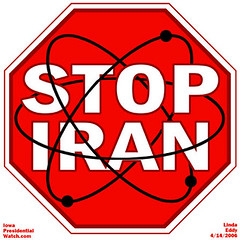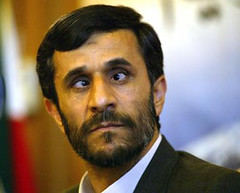Sunday, June 25, 2006
HOW SENIOR MILITARY VIEWS IRAQ and MAIN STREAM MEDIA BIAS
The following comments by Rear-Admiral J. S. concern Iraq:
Seventh Infantry Division (“The Bayonets”)
Fort Carson General and Flag Officers Conference on Iraq, at Fort Carson, COEarlier this week I (a Rear Admiral) attended a retired general and flag officer conference at Fort Carson, Colorado.
The conference was hosted by Major General Bob Mixon, Commanding General of Seventh Infantry Division, which calls Fort Carson its home.
For those of you who are unfamiliar with Fort Carson, it is a huge installation located to the south of Colorado Springs; it’s in the process of becoming one of the larger Army installations in the country (26,000 soldiers); and it is the test location for the new “modular brigade” concept that will reflect the Army of tomorrow by 2008.
It is also the home post of the largest number of troopers who have served multiple tours in Afghanistan and Iraq and, regrettably, the largest number of troopers who have died in combat there over the past three years.
There are Fort Carson units going to and returning from the combat area virtually on a monthly basis.The conference was primarily organized to explain the modular brigade concept, and it featured a panel of officers who had either very recently returned from commands in the combat zone or were about to deploy there in the next two months.
Three of the recent returnees were Colonel H.R. McMaster, Colonel Rick S., and Captain Walter Szpak. McMaster is the commander of the 3rd Armored Calvary Regiment, the unit that, through very innovative and population-friendly tactics, rid the city of Tal Afar of insurgents. For which the Mayor of that Iraqi city has profusely thanked our troops.
McMaster is considered the foremost U.S. expert on modern insurgent warfare, has written a book on the subject which is widely circulated at the war colleges and staff colleges, and he was asked to testify before Congress when he returned from the 3rd ACR combat deployment.
He is obviously one of the great combat leaders that has emerged from the war and is highly respected (some would say revered) by his troopers and his superiors alike.
Colonel S. is assigned to the 10th Special Forces Brigade and he headed up all of the 31 special forces A-teams that are integrated with the populace and the Iraqi Army and national police throughout the country.
Many of these are the guys that you see occasionally on the news that have beards, dress in native regalia, usually speak Arabic and don’t like to have their identities revealed for fear of retribution on their families (thus the Colonel S.)
Captain Szpak was the head of all the Army explosive ordnance teams in Iraq. He and his troops had the job of disarming all the improvised explosive devices (IEDs) and explosive formed projectiles (EFPs) that were discovered before they were detonated.
They also traveled around the country training the combat forces in recognizing and avoiding these devices in time to prevent death and injury. IEDs and EFPs are responsible for the vast majority of casualties experienced by our forces.
Despite the objective of the conference (i.e., the modular brigade concept), it quickly devolved into a 3½ hour question and answer period between the panel and the 54 retired generals and admirals who attended. I wish I had a video of the whole session to share with you because the insights were especially eye opening and encouraging. I’ll try to summarize the high points as best I can.
· All returnees agreed that “we are clearly winning the fight against the insurgents but we are losing the public relations battle both in the war zone and in the States”.
All agreed that it will be necessary for us to have forces in Iraq for at least ten more years, though by no means in the numbers that are there now.
They opined that 80% to 90% of the Iraqi people want to have us there and do not want us to leave before “the job is done”.
The morale and combat capability of the troops is the highest that the senior officers have ever seen in the 20-30 years that each has served.
· The Iraqi armed forces and police are probably better trained right now than they were under Saddam, but our standards are much higher and they lack officer leadership.
· They don’t need more troops in the combat zone but they need considerably more Arab linguists and civil affairs experts.
· The IEDs and EFPs continue to be the principal problem that they face and they are becoming more sophisticated as time passes.
Extended Comments:
Public Affairs: We are losing the public affairs battle for a variety of reasons. First, in Iraq, the terrorists provide Al Jazeera with footage of their more spectacular attacks and they are on TV to the whole Arab world within minutes of the event.
By contrast it takes four to six days for a story generated by Army Public Affairs to gain clearance by Combined Forces Command, two or three more days to get Pentagon clearance, and after all that, the public media may or may not run the story.
Second, the U.S. mainstream media (MSM) who send reporters to the combat zone do not like to have their people embedded with our troops. They claim that the reporters get “less objective” when they live with the soldiers and marines – they come to see the world through the eyes of the troops.
As a consequence, a majority of the reporters stay in hotels in the “Green Zone” and send out native stringers to call in stories to them by cell phone which they later write up and file. No effort is made to verify any of these stories or the credibility of the stringers. The recent serious injuries to Bob Woodruff of ABC and Kimberly Dozier of CBS makes the likelihood of the use of local stringers even higher.
Third, the stories that are filed by reporters in the field very seldom reach the American public as written.
An anecdote from Col. McMaster illustrates this dramatically. TIME magazine recently sent a reporter to spend six weeks with the 3rd ACR as they were in the battle of Tal Afar. When the battle was over, the reporter filed his story and also included close to 100 pictures that the accompanying photographer took.
TIME published a cover story on the battle a week later, allegedly using the story sent in by their reporter. When the issue came out, the guts had been edited out of their reporter’s story and none of the pictures he submitted were used.
Instead they showed a weeping child on the cover, taken from stock photos. When the reporter questioned why his story was eviscerated, his editors in New York responded that the story and pictures were “too heroic”.
McMaster had read both and told me that the editors had completely changed the thrust and context of the material their reporter had submitted.
As a sidebar on the public affairs situation, Colonel Bob McRee, who was also on the panel and is bringing a Military Police Battalion to Iraq next month, invited the Colorado Springs Gazette to send a reporter with the battalion for six weeks to two months.
He assured the Gazette, in writing one month ago, that he would provide full time bodyguards for the reporter, taking the manpower out of his own hide. The Gazette has yet to respond to his offer.
Ten More Years: The idea that we will have troops in Iraq for ten more years sounds rather grim, even though by contrast, President Clinton sent troops to Bosnia and Kosovo nearly ten years ago. And they’re still there with no end in sight.
While Iraq is clearly a different situation right now, the panelists believe that within a few years at the most, it will become very much the same – a peace keeping, nation building function among factions that have hated one another for centuries.
There is factionalism and there was bitter fighting in the Balkans before NATO intervened and with peace keepers, the panelists believe that Iraq will be a parallel situation. This, by the way, is why they all believe that linguists and civil affairs military personnel are so necessary for the future.
Colonel S. went out on a limb by suggesting that if most of the troops in Iraq were deployed home “tomorrow” he could have the entire country “pacified” and the terrorist situation brought under control with just one brigade of special forces. Since these guys are linguists, civil affairs experts, among many other skills and talents, he may not be too far wrong.
Iraqi Attitudes: The panelists agreed that the public affairs problem manifests itself most significantly in the American public belief that the people of Iraq want us out of their country which we are occupying.
They have served in different parts of the country but each agreed that we are wanted and needed there. I refer you to the anecdote from Col. McMaster and the thousands of pictures available on the internet of the U.S. forces shown in very cordial relations with the locals.
Of course, our media’s obsession with Abu Graib and, if the initial reports regarding the small group of Marines at Haditha prove to be true, then those attitudes will change somewhat. But as one of the panelists pointed out, the atrocities suffered under Saddam were much worse and much more common.
Morale and Capabilities: Two weeks ago, the local TV channels showed a 3rd ACR re-enlistment ceremony held at Ft. Carson and officiated by Colonel McMaster. Mind you, this unit has just returned from a one-year combat tour of hard and bloody fighting in Iraq and will likely return there again in eight to ten months.
Of the 670 soldiers eligible for re-enlistment, 654 of them held up their right hands and signed on for another four years. Incredible!
The Army goal for re-enlistments for fiscal year 2006 was for 40,000 soldiers to extend their active duty commitments. With four months remaining in the fiscal year, they have already exceeded their goal of 40,000 and may have to go back to Congress for authorization to exceed their force structure manning limitations.
Since Congress has been pontificating for the past couple of years that the Army is woefully under strength, that should not pose any difficulty.
Iraqi Forces: Every one of the returning commanders had experience in joint operations with the Iraqi soldiers – and in the case of some of them, with the local and national police.
They are all are supportive of the quality of the forces, but culturally, they believe that we may be expecting too much from them as a pre-condition for handing over greater responsibility for area control. McMaster said that he worked with the army and the police at Tal Afar and was not the least bit reluctant to assign major responsibilities to them in the operations that were conducted.
Col. S.’s Green Berets, on the other hand, caught a national police lieutenant who was directing the emplacement of an IED by cell phone in order to disrupt a convoy – immediately after the lieutenant had been briefed on the convoy’s route.
The good news in this situation was that they were able to reroute the convoy, safely, and track the lieutenant’s entire network through the use of the speed dial on his phone. Having terrorist infiltrators in both the army and the police force remains a problem. But by no means does that detract from the courage and determination of those who are loyal to the new Iraq.
Explosive Devices: The combined command in Iraq is becoming increasingly effective in countering the significant threat posed by the IEDs and EFPs. The frequency of attacks has decreased in large part through training to recognize the threat, the new technology (UAVs – unmanned aerial vehicles or drones, for example) which help to discover where the devices are emplaced, the infiltration of some of the terrorist cells, etc.
However, the technology being used by the terrorists is also improving measurably. In the past six weeks, two bomb making sites were found, raided and the bad guys arrested. In both cases, the head bomb makers were master’s degree graduates (one in chemistry and one in physics) from American universities.
That’s a lot of brain power to bring into the fight, but we also have some pretty talented people in the military, industry and academia who are doing their best to even the odds. (And, as per Ge. Casey, Iran has been providing ever increasing amounts of armaments, training and funding).
Conclusion: This is more than I had intended to write on the subject – so what’s new a lot of you might say – but it is a subject that doesn’t get the proper balance from other sources, in my judgment at least.
I trust the information that we received far more than anything that I have heard or seen in our usual news sources. The most disturbing thing that I heard was that our MSM is changing the stories filed by their own people on the scene because they sound “too heroic”.
The over riding opinion that I came away from the conference with is that we have incredibly talented and professional leaders who are facing up to the challenges and are making inexorable progress toward the goals of our nation.
We’re fortunate to have courageous and valorous people on the combat front, even though there seems to be a serious dearth of these same types of people in Congress and the mainstream media.
Subscribe to:
Post Comments (Atom)














No comments:
Post a Comment